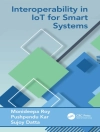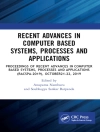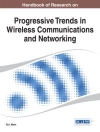A concise, updated guide to the 3GPP LTE Security
Standardization specifications
A welcome Revised Edition of the successful LTE Security
addressing the security architecture for SAE/LTE, which is based on
elements of the security architectures for GSM and 3G, but which
needed a major redesign due to the significantly increased
complexity, and different architectural and business requirements
of fourth generation systems. The authors explain in detail
the security mechanisms employed to meet these requirements. The
specifications generated by standardization bodies only inform
about how to implement the system (and this only to the extent
required for interoperability), but almost never inform readers
about why things are done the way they are. Furthermore,
specifications tend to be readable only for a small group of
experts and lack the context of the broader picture. The book fills
this gap by providing first hand information from insiders who
participated in decisively shaping SAE/LTE security in the relevant
standardization body, 3GPP, and can therefore explain the rationale
for design decisions in this area.
* A concise, fully updated guide to the 3GPP LTE Security
Standardization specifications
* Describes the essential elements of LTE and SAE Security,
written by leading experts who participated in decisively shaping
SAE/LTE security in the relevant standardization body, 3GPP
* Explains the rationale behind the standards specifications
giving readers a broader understanding of the context to these
specifications
* Includes new chapters covering 3GPP work on system enhancements
for MTC, plus application layer security in ETSI TC M2M and
embedded smart card in ETSI SCP; Security for Machine-type
Communication, Relay Node Security, and Future Challenges,
including Voice over LTE, MTC, Home base stations,
LIPA/SIPTO, and New Cryptographic Algorithms
Essential reading for System engineers, developers and people in
technical sales working in the area of LTE and LTE security,
communication engineers and software developers in mobile
communication field.
Table des matières
Preface xiii
Foreword to the First Edition xv
Acknowledgements xix
Copyright Acknowledgements xix
1 Overview of the Book 1
2 Background 5
2.1 Evolution of Cellular Systems 5
2.2 Basic Security Concepts 10
2.3 Basic Cryptographic Concepts 13
2.4 Introduction to LTE Standardization 21
2.5 Notes on Terminology and Specification Language 26
3 GSM Security 29
3.1 Principles of GSM Security 29
3.2 The Role of the SIM 30
3.3 Mechanisms of GSM Security 31
3.4 GSM Cryptographic Algorithms 34
4 Third-Generation Security (UMTS) 37
4.1 Principles of Third-Generation (3G) Security 37
4.2 Third-Generation Security Mechanisms 40
4.3 Third-Generation Cryptographic Algorithms 49
4.4 Interworking between GSM and 3G Security 55
4.5 Network Domain Security 59
4.6 Architectures with RNCs in Exposed Locations 65
5 3G-WLAN Interworking 67
5.1 Principles of 3G-WLAN Interworking 67
5.2 Security Mechanisms of 3G-WLAN Interworking 75
5.3 Cryptographic Algorithms for 3G-WLAN Interworking81
6 EPS Security Architecture 83
6.1 Overview and Relevant Specifications 83
6.2 Requirements and Features of EPS Security 89
6.3 Design Decisions for EPS Security 97
6.4 Platform Security for Base Stations 103
7 EPS Authentication and Key Agreement 109
7.1 Identification 109
7.2 The EPS Authentication and Key Agreement Procedure 112
7.3 Key Hierarchy 123
7.4 Security Contexts 129
8 EPS Protection for Signalling and User Data 133
8.1 Security Algorithms Negotiation 133
8.2 NAS Signalling Protection 136
8.3 AS Signalling and User Data Protection 138
8.4 Security on Network Interfaces 141
8.5 Certificate Enrolment for Base Stations 143
8.6 Emergency Call Handling 151
9 Security in Intra-LTE State Transitions and Mobility155
9.1 Transitions to and from Registered State 156
9.2 Transitions between Idle and Connected States 157
9.3 Idle State Mobility 158
9.4 Handover 161
9.5 Key Change on the Fly 169
9.6 Periodic Local Authentication Procedure 170
9.7 Concurrent Run of Security Procedures 171
10 EPS Cryptographic Algorithms 175
10.1 Null Algorithms 176
10.2 Ciphering Algorithms 177
10.3 Integrity Algorithms 180
10.4 Key Derivation Algorithms 180
11 Interworking Security between EPS and Other Systems183
11.1 Interworking with GSM and 3G Networks 183
11.2 Interworking with Non-3GPP Networks 193
12 Security for Voice over LTE 215
12.1 Methods for Providing Voice over LTE 215
12.2 Security Mechanisms for Voice over LTE 220
12.3 Rich Communication Suite and Voice over LTE 230
13 Security for Home Base Station Deployment 233
13.1 Security Architecture, Threats and Requirements 234
13.2 Security Features 241
13.3 Security Procedures Internal to the Home Base Station244
13.4 Security Procedures between Home Base Station and Security Gateway 247
13.5 Security Aspects of Home Base Station Management 261
13.6 Closed Subscriber Groups and Emergency Call Handling275
13.7 Support for Subscriber Mobility 277
14 Relay Node Security 281
14.1 Overview of Relay Node Architecture 281
14.2 Security Solution 284
15 Security for Machine-Type Communications 293
15.1 Security for MTC at the Application Level 294
15.2 Security for MTC at the 3GPP Network Level 301
15.3 Security for MTC at the Credential Management Level 306
16 Future Challenges 309
16.1 Near-Term Outlook 309
16.2 Far-Term Outlook 314
Abbreviations 319
References 327
Index 337
A propos de l’auteur
Dan Forsberg, Poplatek Oy, Finland
Dr. Dan Forsberg is currently a development manager at Poplatek Oy
where he takes care of the payment terminals area and also works
with payment card industry security. Earlier, Dan led the SAE/LTE
security standardization work in Nokia. He was also nominated as
one of the Nokia top inventors in 2007-2008. Dan started his Ph.D.
studies while working in Nokia and has published several scientific
papers in the area of ‘improving and distributing session key
management for mobile networks’. He joined Helsinki University of
Technology in 2009 and finalized his Ph D studies there before the
end of 2009.
Günther Horn, Nokia Siemens Networks, Germany
Dr Horn is a senior standardization expert at Nokia Siemens
Networks. The focus of his work is on the standardization of 3G and
SAE/LTE security in the 3GPPP security group (SA3), of which he has
been a member since it started in 1999.
Wolf-Dietrich Moeller, Nokia Siemens Networks,
Germany
Wolf-Dietrich Moeller is a senior researcher with Nokia Siemens
Networks.
Valtteri Niemi, University of Turku, Finland and Nokia
Corporation, Finland
Dr Niemi is a Professor of Mathematics in University of Turku,
Finland and also a Nokia Fellow, for which role he is based at the
Nokia Research Center in Helsinki, Finland. Prof. Niemi’s
work has been on security and privacy issues of future mobile
networks and terminals, the main emphasis being on cryptological
aspects. He participated in the 3GPP SA3 (security) standardization
group from the beginning, and during 2003-2009 he was the chairman
of the group.












